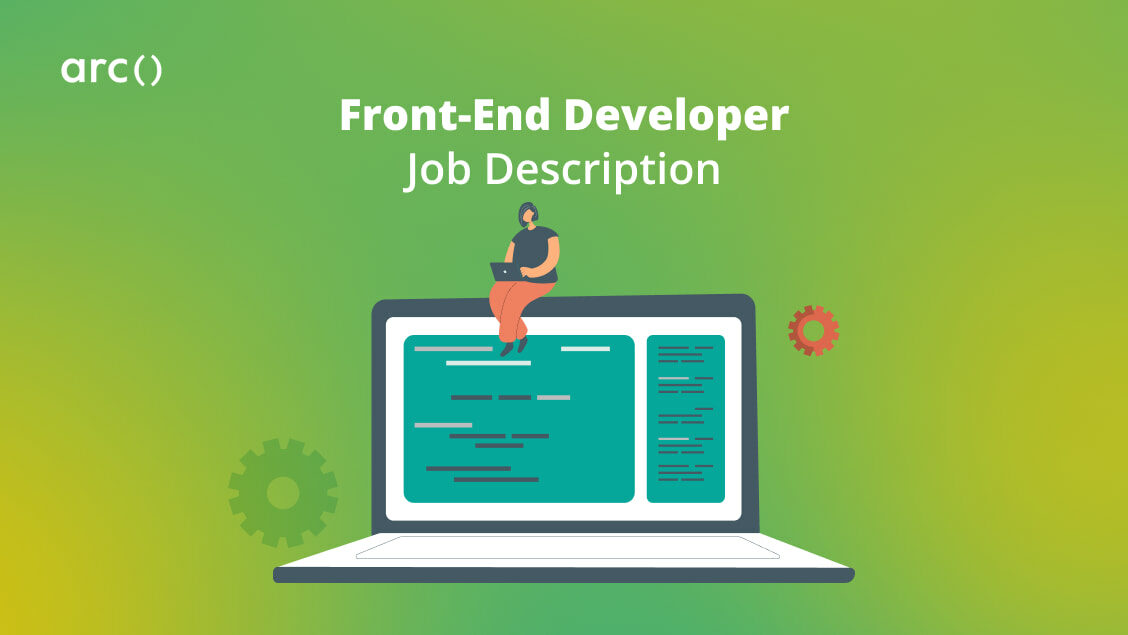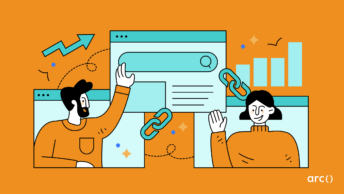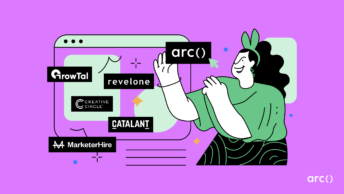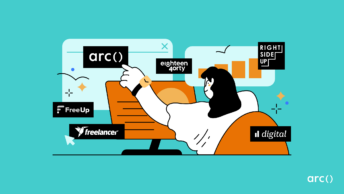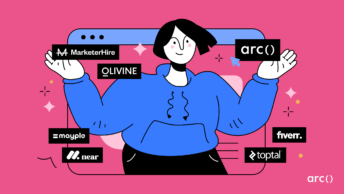As more businesses invest in gaining a solid online presence, front-end developers are in high demand. This is because they meet business needs for sophisticated web design, innovative web development, and intuitive user interface design.
The U.S. Bureau of Labor Statistics forecasts that employment for front-end developers will rise by 13% from 2020 to 2030, which is faster than the average for all occupations.
As you’d expect, the top companies will be doing everything they can to attract the best talents, making it challenging for you to find the best front-end developer talent.
So, how do you compete with the giants and attract great front-end developers?
The answer is in your front-end developer job description.
Thousands of recruiters like you post job ads daily, and if you don’t want your job ad to get lost in the piles of job ads, you need to stand out from the crowd. Your front-end software developer job description must be compelling.
Here’s how to make that happen.
Looking for top talent fast? See how Arc can help you:
⚡️ Find developers, designers, marketers, and more
⚡️ Freelance or full-time remote + fully vetted
⚡️ Save up to 80% with global hires
Hire top talent with Arc risk-free →
Sample Front-End Developer Job Description Template
Here’s an example of a good job description for a front-end developer position.
Please feel free to copy, paste, and edit this sample to suit your needs!
Front-End Engineer, Angular, GraphQL, FlowType (Remote) About Us Here at Arcane Technologies, we thrive on coding solutions that exceed the needs and expectations of our users. Through our portfolio of interactive websites and innovative mobile applications, our users trust us to deliver trustworthy information as soon as it happens. We care about our people, meaning both our users and our employees, and we guarantee you'll feel supported and fulfilled in your software development career if we decide to work together! What You’ll Do ● Translate detailed design comps into clean, organized HTML and CSS. ● Work with the internal and external team to implement bug-free digital experiences. ● Validate implemented solutions work correctly in Chrome, Firefox, Safari, Edge. ● Write performant and accessible web and app components that power beautiful visual design experiences and websites. ● Maintain awareness of new technologies and industry developments that will affect either our users’ behavior or our ability to deliver value. Recommended Qualifications ● 3+ years of experience building applications in JavaScript, Node.js, Angular, GraphQL, React, and FlowType. ● Bachelor’s degree in information systems, web design, computer science, or relevant experience. ● Working knowledge of CI/CD tools such as Travis and Jenkins . ● Strong working knowledge of speed focused techniques like async loading and lazy loading. ● Have experience using source control (GitHub/GitLab) to manage source code and issues. ● You are comfortable working in a remote-first company and understand the importance of timely, detailed communication. Compensation & Benefits ● Competitive base salary, $86,000 – $116,000 ● Unlimited paid time off (PTO) ● Paid parental leave and family care options ● Stock options & 401k/Thrift Plan ● Yearly remote work stipend ● Medical, dental, and vision insurance ● Paid gym membership and self-development courses Get In Touch! If everything above sounds like we'd fit well together, reach out to us! We look forward to hearing from you.
It is important to remember — there is no one way to do this.
As you’ll see, our sample front-end developer job description template above does not include all of our suggestions below.
Adapt your approach based on what creates a truly compelling job description that can attract your ideal candidate. It’s an art as much as a science.
Check out our entire set of tech job descriptions and choose the one which fits your hiring needs best:
- Software Engineer Job Description
- Python Developer Job Description
- Front-End Developer Job Description
- Angular Developer Job Description
- Back-End Developer Job Description
- Cloud Architect Job Description
- JavaScript Developer Job Description
- AWS Cloud Engineer Job Description
- AWS Cloud Practitioner Job Description
- AWS Cloud Architect Job Description
- Scrum Master Job Description
- Full Stack Developer Job Description
- Node.js Developer Job Description
- Cloud Engineer Job Description
- DevOps Engineer Job Description
- Web Developer Job Description
- React Developer Job Description
- Ruby on Rails Developer Job Description
- Agile Product Owner Job Description
- Agile Project Manager Job Description
- Remote Developer Job Description
Or, say goodbye to writing job descriptions altogether with HireAI. Discover top remote developers instantly without manual searching and screening. Try HireAI now!
How to Write a Front-End Developer Job Description
When writing your job description for a front-end software engineer, you must treat it as a candidate will treat their resume. A job description is probably the first contact a candidate has with your company; if it is compelling and inviting enough, it will increase your chances of attracting more talent.
While some general tips apply to most job descriptions, understanding how a front-end developer thinks and works is imperative in making the right points. Here are some vital sections to include:
1. Job title
A job title is the first thing someone sees when looking at a job posting. And it’s probably sitting on a website amongst many other similar job titles, just waiting to be clicked.
You must include “front-end” in your job title, as some people use “web developer” to refer to back-end developers.
The title should be short. It should contain a minimum of two things: the job function and its level in the company. If you are looking for a junior or senior front-end developer, state it clearly, as you don’t want to receive resumes from candidates looking for many different roles than what you need to fill.
Let’s consider these two examples:
Bad example job title: Front-End Developer
Better example job description title: [Remote] UI/UX Front-End Developer | 3+ years | HTML | CSS | Angular
From the two examples, you can see that the correct title is self-explanatory. It tells us right away what the job is and what level it is in the company.
2. About the company
Even though you might think that the job description is about the job itself and the required skills, it is also about your organization. This section is where you introduce your company to the potential candidate by highlighting its advantages, culture, and benefits.
Write this section in a friendly voice, inviting and appealing. When writing this section, think of explaining the company to a friend or a relative.
Here are some points you can include:
- A brief introduction and history of your organization (e.g., started as a small startup, funding rounds, and successful products)
- If applicable, a little bit of data on your customers (e.g., number of users; location).
- Your achievements (e.g., awards, special mentions in press releases).
In this section, you are not going to tell the candidate history they do not care about. Instead, it is about making them aware of your organization’s advantages over other similar companies.
Below is an example of a comprehensive, about us section for an Entry Level Front End Developer role on IBM’s career page:
About IBM
IBM’s greatest invention is the IBMer. We believe that through the application of intelligence, reason, and science, we can improve business, society, and the human condition, bringing the power of an open hybrid cloud and AI strategy to life for our clients and partners worldwide.
Restlessly reinventing since 1911, we are not only one of the largest corporate organizations in the world, we’re also one of the most prominent technology and consulting employers, with many of the Fortune 50 companies relying on the IBM Cloud to run their business.
At IBM, we pride ourselves on being an early adopter of artificial intelligence, quantum computing, and blockchain. Now it’s time for you to join us on our journey to being a responsible technology innovator and a force for good in the world.
This clearly tells candidates how the organization focuses on its culture, innovations in technology, and how it adds value to the world by helping businesses run smoothly. It is clear, concise, and inviting.
Read More: How to Find Software Engineers: The Complete Guide
3. Summary of the role
Your prospective front-end developer candidate already understands what the role entails. However, it is essential for you, the recruiter, to summarize your potential applicant’s role. Let me give you an example, from the career page on IBM’s website.
As a front-end software developer, you will be working as part of a full-stack team in a fast-paced environment developing the next generation of AI-infused management features used in our premier hybrid cloud management product. Working in an agile environment, you will be part of a multi-disciplinary squad working on the user interface within the large global development product group. Your work will involve close collaboration with architects, DevOps engineers, and offering managers across our global organization.
In this section, you may include headings such as “Role summary,” “About the role,” and “Job summary.”
4. Duties and responsibilities
This section is usually an extension of the role summary of your front-end software engineer job description written in bullet points. You want to list all the major tasks that your applicants might be expected to handle.
An example of what this section may look like is from a job posting on LinkedIn by Ceridian:
Most of your work will be in React, but you may also be contributing to WebViews, React Native, and other frameworks.
You’ll know you’re successful when
- You’ve built an evolvable web interface for an innovative experience
- You’ve integrated product analytics and other tools to enable continuous improvement
- You’ve followed and then extended our design system and component library
- You have automated quality assurance, ensuring the quality and speed of iterations
- The interface you help build dramatically and measurably improves Dayforce’s usability
- You’ve developed productive relationships with individuals in similar roles across Ceridian, and your teamwork contributes to users having a consistent, frictionless experience when using Dayforce
- You’ve contributed to the full stack of technologies when it’s helpful and coached other developers in contributing to the UI
Read More: How to Implement a Welcoming Software Developer Onboarding Process
5. Must-have skills and experience
Your job description for a front-end web developer should list the skills and experience required for the position. The must-have requirements are those a candidate absolutely cannot work without. It’s essential to identify these to find candidates with a strong foundation of knowledge.
Here’s an excellent example from Tapcart for a front-end developer (growth) taken from LinkedIn:
- Strong FE experience (HTML, CSS, JavaScript modern frameworks)
- Experience working on greenfield projects
- Design experience is a plus but not necessary
- A dynamic individual who’s not afraid to get their hands dirty!!
6. Nice-to-have skills and experience
A nice-to-have skill is what it sounds like: not a must, but something that would be nice for the candidate to have. It is what can make a candidate stand out from the crowd. For example, if your company wants someone who has expert knowledge of CSS3 but is not really required for the role, you would add it to the nice-to-have categories.
Categorizing skills and experience correctly can have a big effect on who applies, so consider carefully before hitting publish.
Here’s an example of some nice-to-have for a job ad on LinkedIn from the American Red Cross:
- Experience with core AWS services (EC2, VPC, ECS, CloudFormation)
- Experience with MySQL or other relational databases
- Experience in CI/CD DevOps tools (Docker/Jenkins/Nexus)
Read More: 10+ Software Engineer Interview Questions to Find Top Dev Candidates
7. Requirements on education or certifications
You probably won’t need to include requirements for education in your job description. After all, Silicon Valley and the tech industry boast many highly-skilled self-taught front-end developers. By requiring specific qualifications, you’re reducing your potential candidate pool. You may miss out on great front-end software engineers who have been through coding boot camps, self-taught through online courses, or taught themselves by using other resources.
As a general rule, focus on the candidate’s achievements and what each will be expected to accomplish.
However, if your company requires it, go for it. Describe the minimum education level (e.g., Bachelor’s degree, Master’s degree) and the subject areas (e.g., Computer Science, Computational Mathematics).
You may require candidates to have specific licenses, certifications, or clearances depending on your company’s sector and the job they’re applying for. Particularly relevant here are cybersecurity roles (CISSP or CISM, for instance) or if your organization has any kind of contract with the government (for example, facility security clearances, E-Verify, etc.).
8. Working time and location
Working hours are crucial if the company’s headquarters are located abroad but hiring locally. The job description should be clear on the structure of the working time. A good practice is to explain when your team works, whether it is a full-time or part-time position and any flexibility for remote work or self-managed working hours.
The time and location sections should be clear about what is expected from the candidate. Here are some examples:
Working time:
- Full Time (40 hours/week)
- Part-Time (20 hours/week)
- Flexible working hours (may include core hours or time zone overlap requirements)
Location:
- Remote position (work from home or any other location)
- Office-based position (working is only allowed at the office premises)
- Hybrid (working a specific mix of office-based and remote)
Read More: How Much to Hire a Software Developer: Freelance vs Full-Time Costs
9. Compensation, perks, and benefits
It is essential to be transparent about the compensation of the position. If the salary range is negotiable, make sure to mention it.
The compensation and benefits you offer will play a prominent role in attracting talent to your company. Salaries are a key part of the equation, but they aren’t everything. Don’t forget to also mention the other perks and benefits you have on offer.
Apart from compensation, other perks attractive to candidates include:
- A clear work-life balance policy
- Flexible working hours
- Remote work opportunities
- Company culture and core values
- Professional growth opportunities, training, and mentorship
- 401K plan or other retirement options
- Health insurance plans and coverage options
10. Other job description sections to consider
You may find it helpful or relevant to include other information besides those above, especially if your company or situation requires it.
You may want to consider the following:
- Company culture: Even if you have touched on how wonderful it is to work in your organization, it doesn’t hurt to mention it in this section. After all, if you are really proud of your company, why not let the world know?
- How to apply: You can mention how to apply in this section and how to reach out for more information or support.
- Contact information: This is especially important if you want to address concerns or questions about your job ad.
- Legalese: You may have to include disclosures regarding how you will handle their data, affirmative action statements, equal employment opportunities statements, etc., depending on your local or national laws.
- Employment type: You may have to include the type of work and the position you are hiring for: full-time/part-time, contract, etc.
- Screening: Let candidates know if a drug test or credit check is needed before they are hired.
- Hiring process: The job ad should give the candidate an idea of the hiring process. For instance, how many stages might there be until the final round, live assessments, and so on.
- Key dates: This section should include the main dates in the hiring process, for example, when the job application will close. The start date is also helpful, especially if it is still months away.
Read More: How to Decide Between Freelance Developers and In-House Developers
You can also try Arc, your shortcut to the world’s best remote talent:
⚡️ Access 450,000 top developers, designers, and marketers
⚡️ Vetted and ready to interview
⚡️ Freelance or full-time
Try Arc and hire top talent now →
Tips for Writing a Compelling Front-End Developer Job Description
1. Define your job in an inclusive way
Even if you have a great mission statement and you’re committed to diversity and inclusion, your company will only attract diverse candidates if your job descriptions are designed to appeal to everyone.
Many companies unintentionally create descriptions that are more likely to appeal to men than women, such as by using overly masculine or overly aggressive language.
If you need help finding inclusive alternative wording options in your front-end developer job description text, check out both the free and straightforward Gender Decoder and the feature-rich Textio.
2. Format your job description to make it easier to read
Once you have the perfect wording, you need to format it correctly — especially for compatibility with mobile devices. If it’s easy for candidates to skim and digest your message, they’ll be more likely to apply.
Use short paragraphs bullet points and include plenty of white space. This helps break the text into manageable chunks, making the job seem less overwhelming.
Read More: What’s the Difference Between a GOOD Developer and a GREAT Developer?
3. Use the second person singular point of view in your writing
Taking a second-person point of view makes the reading experience more intimate and less detached, making it easier to empathize with the narrator.
It feels immediate and surrounds the reader when the narrator turns the reader into one of the characters. The result: a more engaging job description.
An example of this would be “You have great potential at our company” or “We value diversity and see you as an asset. Interested in the role?”
4. Provide specific instructions when applying
How to apply should always be included in your front-end developer job description, but it’s helpful to also have details and specific instructions. This also helps to weed out unqualified candidates early, saving everyone’s time.
For example, you could instruct applicants to include the word “Web” somewhere in their application, so you can identify people who skimmed through your job ad’s title and didn’t engage with the content.
Read More: How to Build an Entire Remote Software Development Team
5. Add a call to action at the end of your job description
A call to action is a phrase or sentence intended to motivate people to take a specific action. When it comes to front-end developer job descriptions, a good call to action could encourage candidates interested in the position to apply.
For example, a good CTA can be along the lines of: “Ready to join a team that’s passionate about saving the planet? Hit the Apply now button to take the next step.”
Wrapping Up
Crafting a great front-end engineer job description is an art, not a science — but if you’ve covered the sections and tips in this article, you’re already on the path to finding your perfect candidate.
Need help finding a pre-vetted front-end developer? Come have a chat with us!
You can also try Arc, your shortcut to the world’s best remote talent:
⚡️ Access 450,000 top developers, designers, and marketers
⚡️ Vetted and ready to interview
⚡️ Freelance or full-time


